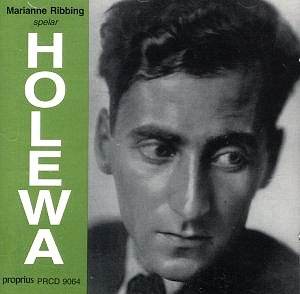I referred recently to the Proprius
anthology of Hägg and Josephson piano solos as 'well
behaved piano stool miniatures'. Holewa's piano music is quite
a different proposition. He drank deep at the Second Viennese
well. The influence here is Schoenberg rather than the 'sour'
lyricism of Berg or the out and out objectivity of Webern. Across
the years covered we note a trajectory from the Pierrot Lunaire
astringency of the Three Preludes and the Sonatine
into the quasi-romantic excrescence of the Fyra pianostycken.
The Preludes and Sonatine are in awed respect
of Schoenberg's precepts. Given that the Sonatine was written
only one year before the Four Pieces the contrast is remarkable
not that they are a complete abnegation of Schoenberg's style
as the so-called allegro moderato proves. It is remarkable,
by the way, that despite what you are led to expect by the declared
tempo markings, most of these pieces proceed at a middling moderato.
Even the schnell of the Tre preludier only snaps
the moderato bonds in little impetuous outbursts rather
than in a wholehearted rush of blood. For the Liten svit we
are back to the style of the Tre preludier and their moderato
pacing. If there is a weakness in this music it is its lack of
variety of tempo - its generalised middling rate of progress.
The Inventioni of three decades later shows how Holewa
remained true to his adopted style but with something I take to
be an Iberian flavour cut with the melancholy melodrama of the
Tre preludier. It also recalls the Lisztian fist-shaking
and turbulence of the Howard Ferguson Piano Sonata.
Marianne Ribbing's performances which have a
bejewelled delicacy and slender steely strength must be taken
to be faithful to Holewa's intentions. The notes are in Swedish
and German only.
Rob Barnett
